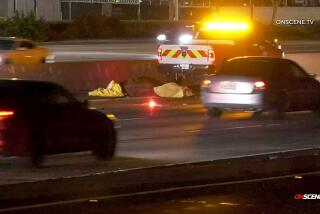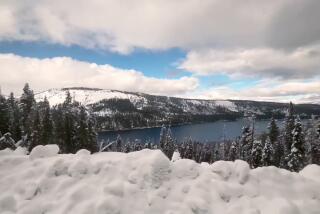On the trail of the Pony Express
Reporting from Sacramento, Salt Lake City and St. Joseph, Mo.
Bill Gates’ career as a Harvard undergrad. Elizabeth Taylor’s second, fourth, fifth, seventh and eighth marriages. Sarah Palin’s tenure as Alaska governor. Barack Obama’s stint as U.S. senator from Illinois.
As brief as they were, each of these events lasted longer than the Pony Express. Yet here I stood at the Pony Express National Museum in gritty St. Joseph, Mo., a few blocks from the banks of the Missouri River, surrounded by Pony maps, Pony portraits, Pony artifacts, Pony dioramas, Pony mannequins, a vintage neon PONY EXPRESS MOTEL sign and a reconstructed Pony stable.
“Danger has intrigue to it,” museum volunteer Bill Keck was telling me. “And what these riders went through! We hang on to those kinds of things.”
In its 19 months of operation in 1860-61, the Pony Express relied on scores of brave or foolish young men and hundreds of barely broken horses to deliver the speediest mail service in North America, despite forbidding topography, nasty weather, stampeding bison and hostile Native Americans. At a time when most mail took three weeks or longer to travel the nearly 2,000 miles from Missouri to California, the relaying Pony riders could do it in 10 days, sometimes less. And they always started in St. Joe.
So here I was, 150 years later, ready to learn how a failed business — an estimated $400,000 in debt when it shut down — was born again as one of America’s best-loved Western stories.
No, I didn’t have a horse tied up outside. If I were that devoted to the Pony Express, I’d be joining the hundreds of spur-wearing faithful who plan to cover the entire route in a celebratory “re-ride” caravan beginning June 6 in Sacramento. They’ll do it in 20 days, a lazy, west-to-east stroll compared with the 10-day blitzes that the National Pony Express Assn. stages in nonsesquicentennial years.
Me, I rode 737s and rental cars all the way. Three cities, east to west, four days. When you’re plying a 20th century trade (newspaper reporting) in search of a 19th century story, every little bit of modern technology helps, especially if you also have a 21st century electronic beast, latimes.com/travel, to feed.
In 1860, St. Joseph, in northwestern Missouri, about 50 miles from Kansas City, was where “civilization” ended and the Wild West began. The railroad tracks stopped in St. Joe (which got its name from founding trader Joseph Robidoux), and so did the telegraph lines. The town stretched over several abrupt hills, giving pleasant views of the river, and the streets downtown were named for some of Robidoux’s many children. About 9,000 people lived here, including numerous wheelwrights, saddle-makers and dry-goods merchants, many Southerners with Confederate sympathies, along with an energizing number of westbound, cash-bearing, wagon-buying, supply-needing gold-seekers and settlers.
Anybody who was anybody stayed at the big, brick Patee House, the fanciest hotel west of the Mississippi, which had a barber, a ballroom and a guest roster that included journalist Horace Greeley, Mark Twain and British author-explorer Sir Richard Francis Burton.
“Other towns on the Missouri may have a grander future; I doubt that any has a finer location,” Greeley wrote after his 1859 visit.
In April of the next year, the first Pony rider probably mounted a horse from the wooden stables at 9th and Penn streets (now the site of the Pony Express National Museum), then collected his load from the dispatch office at the Patee House, now the Patee House Museum. Then he would have set off to catch a ferry across the Missouri into the raw territory that would soon be known as the state of Kansas.
By some accounts, that first load included just 49 letters, five private telegrams, some Eastern newspapers and a bunch of telegraphic dispatches to be printed by Western newspapers. The riders, often teenagers, typically weighed 120 pounds or less, were issued lightweight Bibles and signed an oath that said that “I will, under no circumstances, use profane language, that I will drink no intoxicating liquors, that I will not quarrel or fight with any other employee of the firm,” and so on.
Pay was $50 to $100 a month (accounts vary). They rode with pistols or a rifle or unarmed. After 25 miles or so, that first rider would trade his horse for a fresh one, and after 100 miles or so, he would hand his letters off to another rider. On they would sprint through Kansas, Nebraska, Colorado, Wyoming, Utah, Nevada and finally California, except for those who died from Indian attack, exposure to the elements or just plain falling off their horses.
It was risky and, in a smelly, sweaty, flies-and-mosquitoes-by-the-cloud sort of way, romantic. On April 3, the Pony Express National Museum kicked off its sesquicentennial year with a reenactment of that first ride. Despite wind and rain, hundreds of locals and visitors showed up to cheer.
Greeley was wise to be guarded about St. Joe’s future. The Civil War took its toll. Then Kansas City stole St. Joe’s glory by getting the trains rerouted and building the first railroad bridge over the Missouri River. Over the decades, Kansas City boomed, and St. Joseph slowed.
In fact, St. Joe’s population has been flat for the last century at about 75,000, and the Museum Hill area downtown is full of brick Victorian homes, some painstakingly restored, others as idle and weather-beaten as Roman ruins. The West’s jumping-off point has been jilted.
But it has some fascinating museums.
In the Pony Express National Museum, which had almost 40,000 visitors last year and just completed an upgrade, I scanned old photos of riders David Jay (who, with his droopy mustache, looked like Daniel Day-Lewis); Pony Bob Haslam (said to have ridden 380 miles in 36 hours despite taking an arrow in the mouth and another in the arm in an Indian ambush on the way); and Bronco Charlie Miller (the youngest known Pony rider, who took to the trail as a substitute at age 11).
Along the way, the museum covers the main questions and raises a few you might not think to ask.
Who started the Pony Express? Russell, Majors & Waddell, the leading freight-hauling and military supply company in the West. And the Pony Express’ official name was the Central Overland California & Pike’s Peak Express Co.
By 1860, it was well understood that the train and telegraph would soon connect California with the East, knitting North America together with a new intimacy. But in the meantime, there were prospectors and settlers desperate to be in touch with the East, and there were government men eager to nudge the populace westward. Also, with the Civil War threatening, Northerners were eager to forge more direct connections with California, cutting Texas and Arizona out of the action.
On Jan. 27, 1860, partner William Russell sent a telegram to his son: “Have determined to establish a Pony Express to Sacramento, California, commencing 3rd of April. Time ten days.” This gave the newborn company all of 67 days to hire riders, establish stations and buy horses.
How long was the route? Estimates vary, as did the riders’ routes. Some say 1,840 miles. Some say 1,966.
How many riders did it take to get a letter from St. Joe to Sacramento? About 25, usually riding 75 to 100 miles each.
Did the transcontinental train kill the Pony? No. The train didn’t go through until 1869.
But the first coast-to-coast telegraph message went through in October 1861, and the last Pony letters were delivered the next month. Russell, Majors & Waddell went into a corporate death spiral. The St. Joseph stables burned in 1888, were rebuilt with bricks, fell to other uses, then fell idle for years until a local philanthropist bought the site. (The museum opened in 1959 as a subsidiary of the St. Joseph Museum, then broke off on its own and expanded in the 1990s.)
From the stables, it’s just a few blocks east to the Patee House Museum. This four-story brick box of a building, which dates to 1858, must have once seemed the center of American civilization west of the Mississippi. But when I stepped up, the front door was locked.
Not enough volunteers, director Gary Chilcote told me when I called on my cellphone. Then he opened up for me.
“It was a hotel three times and a girls’ college twice, and it was a shirt factory for 80 years,” Chilcote said, striding room to room, turning on lights.
The building became a museum in 1963 and Chilcote, 75, a longtime reporter and editor for the St. Joseph News-Gazette, has been involved since the beginning. He runs it with help from family members and estimates 20,000 visitors last year.
He set up the ground-floor Pony Express office area to look as it might have 150 years ago. He has trains, including a mail-sorting car from 1862. He has buggies, cars and fire trucks. He has an upstairs ballroom where authorities held court during the Civil War (and condemned seven men to be hanged across the street). He has a working carousel from 1941, a bar where you can order sarsaparilla, a 1,000-pound ball of yarn and weapons used in long-ago local homicides.
“You understand,” he says conspiratorially, “that what we’re doing here is writing feature stories and putting them in a case.”
Before heading west, I felt my way to the river’s edge, where the Remington Nature Center opened next to Terrible’s Casino in 2008. The river was at my feet, plain and brown and running fast. If I looked straight across to the thickets on the other side, I could almost imagine some terrified teenager on horseback, galloping off into who knows what.
About four days and 1,000 miles west of St. Joseph, Pony riders would carry their letters down out of the Wasatch Range and show up at 143 S. Main St. in Salt Lake City, the Salt Lake House Hotel.
The city of Salt Lake in 1860 was younger than most of the Pony’s riders. But already, Salt Lake had about 8,200 residents and it was growing fast.
The Mormon faithful, who had been expelled from Missouri in the 1830s and driven from Illinois in the 1840s, were busy sinking roots. They farmed, practiced polygamy (which wouldn’t be banned for 30 more years) and slowly but steadily carted and stacked granite blocks to build a temple in the middle of town.
Many Mormon boys rode for the Pony and probably had the chance to gallop near the spot where Brigham Young in 1847 declared “This is the place.” From the Wasatch range, the route led right down Main Street and out to Camp Floyd, 40 miles southwest, where 3,500 federal troops — nearly a third of the U.S. Army — had been stationed in case the Mormons rebelled. (They didn’t. The camp is a state park now, with a little museum in the old Army commissary building.)
These days, Salt Lake City is home to about 180,000 people, about half of them Mormon. On the spot where Brigham Young made his pronouncement, visitors now find This Is the Place Heritage Park, a 450-acre pioneer history park. Costumed staffers tend to 19th century chores. There are pony rides, a petting zoo, historic buildings, and statues celebrating the Mormon pioneers and the Pony Express. Every day in summer, a latter-day Pony rider dashes through.
Things are quieter at 143 S. Main St., the old handoff spot. On the site stands a handsome 1927 building that was home to the Salt Lake Tribune for about seven decades until the paper moved elsewhere in 2005. Now the space is empty. There’s a Pony Express plaque on the wall, and that’s about it.
On the brighter side, look how well that Mormon temple-building project turned out. As you can see just a few blocks away, they finally finished that temple in the early 1890s. It rises 210 feet, topped by a golden angel, flanked by fountains, statuary and manicured gardens. Yet the building continues. In the same neighborhood, the Mormon Church is redeveloping a 20-acre chunk of downtown with new housing and retail in place of old retail, a billion-dollar project to be completed in 2012. I’ve never seen so many clean-cut construction workers.
And missionaries, of course. Within five minutes of my arrival outside the temple, two young women approached me, one from Arizona, one from Korea, both eager to tell me about the Mormon religion.
I was just as eager to tell them about the Pony Express. It was a stand-off there on the sidewalk, my degree of interest in their message mirrored precisely by their degree of interest in my message. We went our separate ways, grinning awkwardly.
Sacramento was already a big city in 1860, bursting with nearly 14,000 residents, most of whom had arrived since the discovery of gold at Sutter’s Mill in 1848. (These days, Sacramento has 465,000 residents.) The city was also about to be hit with a historic flood in December 1861, which would prompt a massive civic effort to lift up the entire city. By the 1870s, most of Sacramento’s key buildings would be raised as much as 18 feet higher than they were in 1860.
The city’s riverside location meant easy steamboat traffic to San Francisco and made it a natural terminus for the Pony Express.
Now, here, I have to admit that I’ve always found Old Sacramento kind of cheesy. Though it sits by the Sacramento River, the Tower Bridge looming above and the Capitol building a few blocks off, the boardwalks and Old West tourist shops always seemed best suited for tourists under age 12, and the hum of the neighboring freeway seemed just a little too loud. But when you arrive in Sacramento after several days of retracing 19th century tracks, Old Sac seems not only logical but almost ideal. I even sprang for an eight-block clippity-clop ride in a horse-drawn carriage.
I walked up and down the final block of the original Pony Express riders’ route. I chatted up the volunteers with the California State Railroad Museum as they maneuvered a locomotive. And as soon as it opened for the day, I jumped across the threshold of the B.F. Hastings Building.
This storefront, built in 1853 at 2nd and J, was the Pony Express office. At various times, it has also housed the Alta Telegraph Co., the state Supreme Court and Wells Fargo. Now it’s a tiny museum, the Wells Fargo History Museum, just updated to include more Pony Express details.
From that first batch of Pony Express mail, historians say, eight letters were addressed to Sacramento, and 25 more were carried aboard the boat to San Francisco. By the last months of the cash-strapped Pony’s operations, about 35,000 letters had been carried by its riders. Wells Fargo had taken over many operations west of Salt Lake City, and many riders stopped at Folsom or Placerville.
Then on Oct. 24, that first transcontinental telegraph message went through. Two days later, the Sacramento Bee offered up an institutional obituary: “Our little friend, the Pony, is to run no more.... Nothing that has blood and sinews was able to overcome your energy and ardor; but a senseless, soulless thing that eats not, sleeps not, tires not … has encompassed, overthrown and routed you.”
Yet by many measures, this was the beginning of the fame of the Pony Express.
Richard Francis Burton, the English author who had come west to investigate the Mormons in 1860, wound up writing at length about the Pony Express in “The City of the Saints and Across the Rocky Mountains to California,” published circa 1861-62. Mark Twain, who crossed paths with a rider in Nebraska in 1861, set down his description in the 1872 book “Roughing It.”
“Away across the endless dead level of the prairie a black speck appears against the sky,” Twain wrote.
Then there was artist Frederic Remington, who painted “The Coming and Going of the Pony Express” in 1889.
But the Pony’s greatest posthumous promoter may have been Buffalo Bill Cody, whose Wild West show toured North America and Europe from 1883 to 1916. Though other parts of the show came and went, there was always a segment telling the tale of the Pony Express.
“This was not the West of the mindless slaughter of the buffalo, the decimation of the Indian, or the greedy exploitation of the land. This was not the West of gunfighters or cattle rustlers,” writes Christopher Corbett, author of “Orphans Preferred: The Twisted Truth and Lasting Legend of the Pony Express.” Instead, Corbett writes, “The story of the Pony Express was about a lone rider facing the elements, racing time and racing the transcontinental telegraph, too.”
If you step out of the old Pony office at 2nd and J in Old Sacramento and look to the opposite street corner, you’ll see what I saw at end of my excursion on the Pony trail: a batch of plaques and a tall sculpture of a very young rider with a hawkish face, ferociously urging his horse onward. He is a Pony Express rider, he is doomed, and he just might live forever.
christopher.reynolds@latimes.com
More to Read
Sign up for The Wild
We’ll help you find the best places to hike, bike and run, as well as the perfect silent spots for meditation and yoga.
You may occasionally receive promotional content from the Los Angeles Times.







